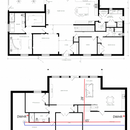Plumbing, hot water tank, homerun system and DWHR
Hi
Wanted peoples opinion on my hot water system, so to start my house is built and its long with bathrooms at each end but plumbing is not completed . So currently the plan is to have the hot water tank at the end with the en-suite, also planned DWHR at each shower drain (full 4″ vent stakes at each end). As attached the distance from the hot water tank to the second shower is 65′ and roughly the same to the kitchen. So questions,
1. Would you do a regular electric hot water tank or heat pump or a pair of smaller electric tanks? ( house is full electric and heated with a pair of ductless mini-splits)
2. would a home run distribution system make sense in this home, most plumbers told me to run 3/4″main line and just tee off 1/2″. (PEX tubing )
I have read the links on home run being more efficient but not sure with such long runs, also what happens to the lines that water sits ( shower doesn’t get used for a week or two? )
3. The plan was to use 4″ DWHR 72″ long, at both showers but was told only run the one closer to the tank back to the tank and the other DWHR back to the hot side of the shower. I wonder pay back on the second if its not used or hooked up to the tank, opinions ? Also preferred brand, I was looking at power pipe.
Thanks Dave
Zone 6.
GBA Detail Library
A collection of one thousand construction details organized by climate and house part










Replies
Dave,
Since you are all electric, probably the best is to put a larger heat pump water tank near your main bath area, from that run a 3/4 hot water feed to smaller (10 or 20 gal) resistance water tank near your other bath/kitchen. Just make sure to get the small tank with 3/4" ports.
This way the HPWH does most of the heating, the small tank at the end has to only heat the water that cools off over time in the main feed, it should barely run.
There is no point in home running over large distances. Just have two manifold sets, one on each end that you locally home run your fixtures to.
Recirc pump triggered from a motion sensor in the far bath might be another option, but I think the cost and energy use would be more than the mini tank.
For heat recovery on the far bath, the unit needs to connect up to the COLD water feed to the shower. You should also spec a shower with a thermostatic valve. What happens is as the heat recovery kicks in, it warms up the cold water running to the shower. The shower valve senses this and uses more of this warmer water and less of the hot water from the tank to maintain the same shower temperature.
This is the recommended install method from most DWHR manufacturers. There is no need to plumb this back into the water tank.
The instructions for my DWHR unit gave three options for plumbing. 1. Connect to shower cold intake 2. Connect to water tank cold intake 3. Split and connect to both. Option number 3 was listed as the preferred, with both others described as similarly less efficient.
Hi Dave,
I'm glad to see you are thinking of Drain Water Heat Recovery but does will it make sense to do this in the second bathroom if it will rarely be used for showering?
I like it for the master bathroom and be sure to plumb a tee from the DWHR to the cold water side of the master bath shower mixer. This is called equal flow plumbing and there are many diagrams available from manufacturers for clarification.
For the guest bathroom consider a demand controlled hot water recirc pump. These are typically located under the sink vanity. When a button is pressed in the guest bath, the pump moves hot water to the bathroom and when it arrives, the pump switches off. No waiting, and no wasted water down the drain. Don't home run to fixtures in the second bathroom, or at least use a manifold located at the guest bath, especially if you employ this demand controlled recirc loop.
A good heat pump hot water heater under the master bathroom with DWHR and a demand controlled recirc loop to the guest bath should be a very efficient and cost effective system. And be sure to insulate all hot water lines and install low flow or Watersense labeled plumbing fixtures.
+1 to Matt's comments above. I would add that it doesn't add much cost or complexity to run the main recirc line out to and back from the kitchen before going out to the guest bath. With a smart recirc pump (take a look at the Metlund website) installed at the guest bath, the pump shuts off when warm water reaches it. The pump can be activated from the kitchen or guest bath, providing warm water at the fixtures to both. This does increase your standby pipe losses a tiny bit because of the double length kitchen loop, but this is most likely made up for by additional water savings not waiting for hot water at the kitchen sink.
Thanks for all the replies, I will look into the recriculation pump and ditch the second DWHR. Having the pump go to the bathroom and kitchen would be nice, have to see how that would work, switch, hot water sensing or other options?
Any preference on DWHR makes, power pipe ,eco drain, others?
Also I'll skip the home run system, and maybe run manifold at either end of the house.
Thanks again for comments